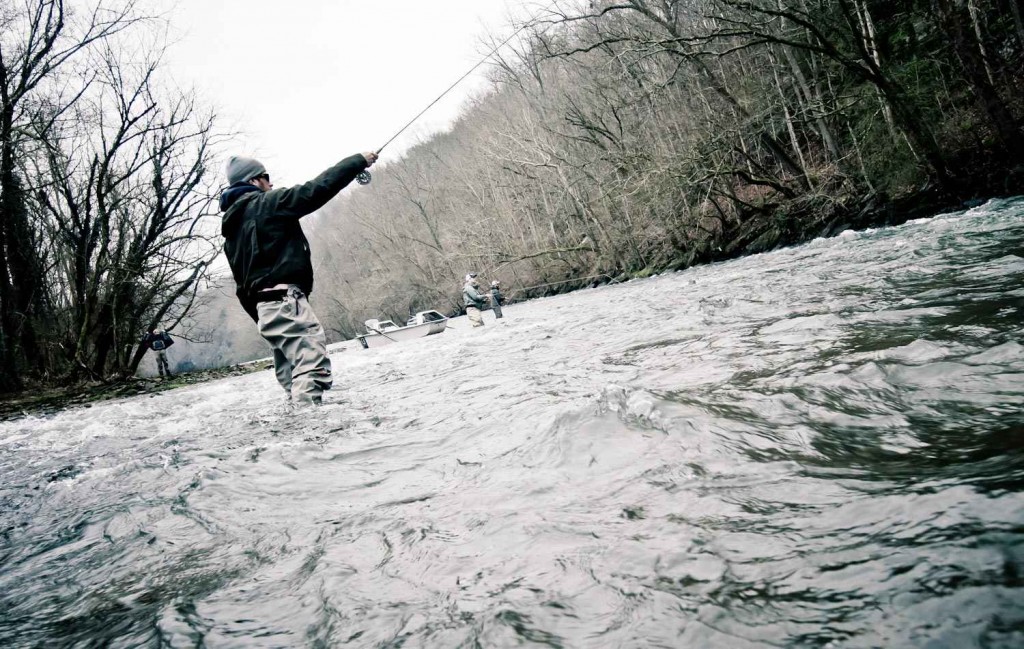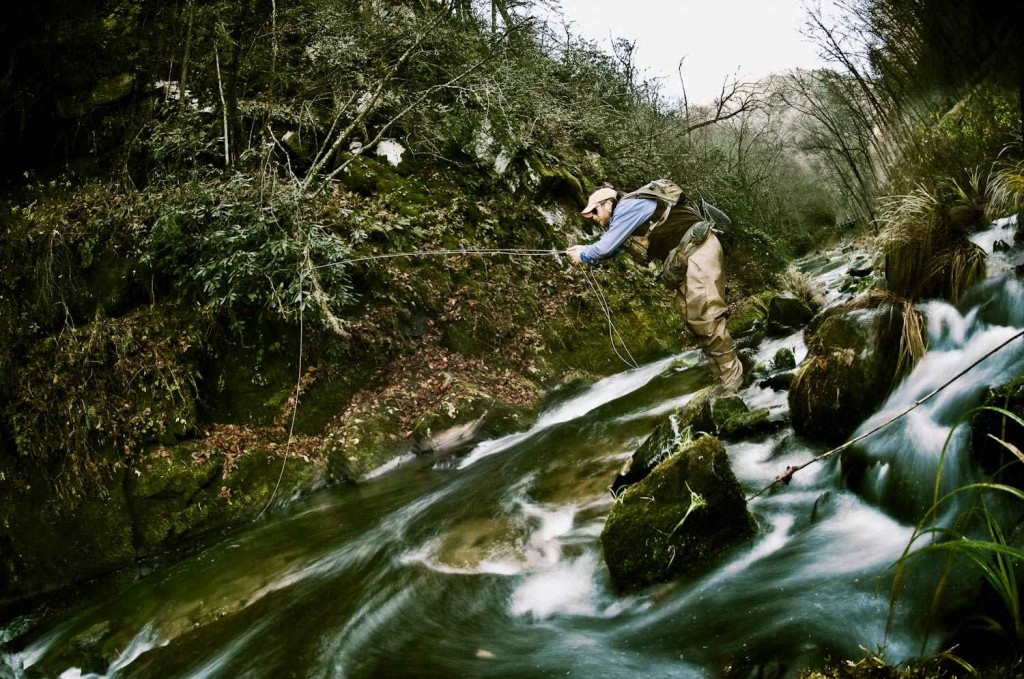Better High-Sticking Technique
Now that I’ve got your attention, let’s talk about how important it is when high-sticking a fly rod to always utilize both of your arms during your drift. Perfect line management while high-sticking, often boils down to managing inches of fly line and leader. In many cases, it only takes a foot or less of fly line or leader on the water to catch current and destroy your drift. Many of my novice clients, and even some of my advanced clients, regularly high-stick with only one of their arms; choosing to keep their line hand and arm positioned down by their side during the drift. I don’t like high-sticking with only one arm for two reasons.
Reason #1 – High-Sticking with two arms promotes better line management
When high-sticking, you often need to micro-manage your fly line with small strips to keep 100% of your fly line and leader off the water during your drift. If you keep your non-rod arm straight down at your side, you’re not able to strip any additional line in during your drift. When high-sticking correctly, fly anglers should only have their strike indicator or dry fly on the water during their drift, keeping the rest of their leader and fly line off the waters surface. Done correctly, it will minimize the ability of conflicting water currents (currents flowing at different speeds) to have negative effect on your drift. If your nymphing, your flies will sink quicker and stay down in the strike zone longer, and if you’re dry fly fishing, your dry fly will stay drag-free and float the same speed as the current throughout your drift. With both fly fishing rigs, high-sticking correctly can consistently double your drift time in the prime trout water, and that means your flies will stay in front of the fish longer and hookups will increase. Utilizing both of your arms and hands when high-sticking will promote better line management and give your flies a more natural looking drift. Keep in mind that the closer you keep your stripping hand to your fly rod the more accurate and precise you can be with your strips and line management.
Reason #2 – High-Sticking with two arms puts an angler in better position to fight a fish
The second reason anglers should utilize their second arm and hand when high-sticking is they will be much more prepared after a hook-set to quickly strip-in if tension is lost. Quite often, trout will swim straight at you after being hooked, and slack can quickly be created between the fish and your rod tip if not eliminated immediately. Many fish are lost during the first seconds of the fight, and by keeping your non-rod arm functional when high-sticking, you’ll decrease the chances of tension being lost during the fight, and you’ll land more fish.

Upon request and bartering a cold beer, Dave Grossman demonstrates the one arm high-stick. Photo By: Louis Cahill
Further Comments
I tell my clients all the time that high-sticking technique that’s 90% correct is good, but it’s that 10% of incorrect technique, that’s keeping them from consistently catching fish. These small percentages of technique angling error cause anglers to miss strikes and keep them from getting satisfactory drifts. Yes, there are times when you can get away with using only one arm when high-sticking. For example, when you’re repeatedly making the same presentation over and over, but don’t make the mistake of thinking it’s alright for all high-sticking situations. Next time you’re on the water and high-sticking, make a point to consistently use both of your arms and you’ll be high-sticking and catching fish like a pro. I know there are a lot of disabled fly anglers out there, that may only have one functioning arm and hand. This post is obviously not meant for these anglers.
Keep it Reel,
Kent Klewein Gink & Gasoline www.ginkandgasoline.com hookups@ginkandgasoline.com Sign Up For Our Weekly Newsletter!

Great stuff fellas. Once again a little nugget from Gink that will improve my skills. Thanks!
Jason,
Glad you liked it and thanks for returning a nice comment.
Kent
Great tip, Thanks for sharing.
Trap,
Thanks man, fish on.
Kent
Ditto. I like how you guys manage to impart some very practical tips, and mix them in with more ‘philosophical’ stuff. Keep it up.
Ron,
We loving hearing feedback from followers that our content is Being enjoyed. Thx for supporting G&G
Kent
Great blog. I learn alot. I check it every day.
The photo of 7.17.12? N. Carolina location? Macon Co.?
Upper N?
THANKS.
Upper N
Yep. Exactly…the tuffs of grass were the first sign. Know that spot exactly. Can always be counted on for a couple of sure fish in the slot and in the eddy out.
Some good year water. Thanks for all you do for the sport.
Pingback: Speyburn’s Best Catch Contest, Improve Your High Sticking Technique, Heat Wave Hurts Michigan’s Pike Population | MidCurrent
It seems so elementary – I hold the line with my left hand in every other situation, so why not high sticking? Good lookin’ out.
You guys are the best. Keep bridging the gap of the “how” and the “why” … you’re the only ones who do it well.
Stephen,
Thanks for the nice comment and letting us know this post helped you out. It’s not always clear what kind of tips I’m going to write, so I generally fall back on what I see over and over again, when I’m guiding. Then ask, “what do most people do wrong that keeps them from catching fish”. Sometimes, it’s the easy stuff 🙂
Kent
Kent,
Perhaps you can comment- When high sticking in a tight stream with lots of trees and shrubs on the bank, setting the hook on an empty take can easily result in your flies and indicator in the branches. Is it possible to use the second hand on the line to set the hook with a line pull under these circumstances?
Rich,
I think my first recommendation in this situation would be for you to side the hook downstream sidarm or sideways. That should keep your flies and rig out of the tres 100% of the time and you won’t be second guessing your hook sets. Th only time I personally use strip sets for trout is when I’m streamer fishing with little slack in my fly line.
Kent